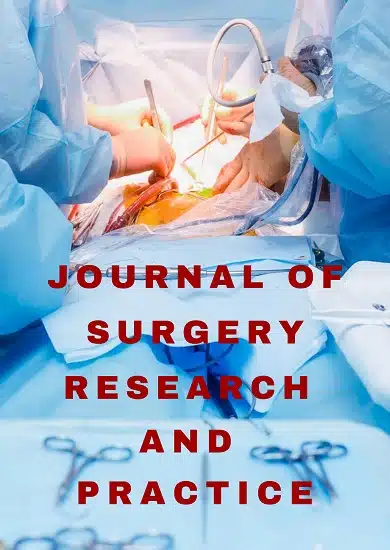Case Report | Vol. 6, Issue 1 | Journal of Surgery Research and Practice | Open Access |
Hot Dog Bun Technique for Laparoscopic Oophropexy: A Panacea for Recurrent Ovarian Torsion?
Shazia Khan1*, Saranya Krishnan2, Sushil Chawla3
1Associate Professor, Department of Obstetrics and Gynecology, INHS Asvini, Mumbai, Maharashtra, India
2Resident (PGY 3), Department of Obstetrics and Gynecology, INHS Asvini, Mumbai, Maharashtra, India
3Professor and HOD, Department of Obstetrics and Gynecology, INHS Asvini, Mumbai, Maharashtra, India
*Correspondence author: Shazia Khan, MBBS, MS (Obs and Gyn), FMIGS (APAGE-MIT), Associate Professor, Department of Obstetrics and Gynecology, INHS Asvini, Mumbai, Maharashtra, India; Email: [email protected]
Citation: Khan S, et al. Hot Dog Bun Technique for Laparoscopic Oophropexy: A Panacea for Recurrent Ovarian Torsion? J Surg Res Prac. 2025;6(1):1-7.
Copyright© 2025 by Khan S, et al. All rights reserved. This is an open access article distributed under the terms of the Creative Commons Attribution License, which permits unrestricted use, distribution, and reproduction in any medium, provided the original author and source are credited.
| Received 16 December, 2024 | Accepted 11 January, 2025 | Published 18 January, 2025 |
Abstract
Introduction: Ovarian torsion is a gynecological emergency that can adversely impact future fertility if timely diagnosis and immediate surgical corrective actions are not taken. Most cases of torsion occur in young women of reproductive age with either ovarian or para-ovarian masses. Recurrent ovarian torsion occurs in 11-18% of cases. Timely detorsion and oophropexy remain the gold standard to prevent future recurrence.
Case and Method: A 13-year-old girl arrived at the emergency room complaining of stomach ache on the left side. She had previously presented with similar complaints 2 times and was diagnosed with left ovarian bilobed cyst of 8 x 8 cm with torsion followed by spontaneous detorsion. Due to recurring torsion, it was decided to take her up for laparoscopic detorsion, cystectomy and ovarian fixation. We performed the newer technique of Oophropexy where uterovarian and round ligaments used as buns and fallopian tubes as hot dog placed in between them by a suture in an atraumatic manner. This protects the fallopian tube while also reducing the lengthy pedicles’ range of motion. The patient was discharged and followed upto 4 months post operatively. She had no recurrence of cyst or torsion.
Conclusion: There is no dearth of techniques of oophropexy and the best technique remains debatable. But the simplicity and effectiveness of this logical surgical technique makes it an effective tool even in necrotic ovaries with large pedicles whilst preserving the anatomy.
Keywords: Laparoscopy; Ovarian Torsion; Oophropexy; Hotdog in Bun Technique; Cystectomy
Introduction
An ovarian torsion is a partial or total rotation of the ovary around its ligamentous supports. As it leads to disruption of ovarian blood supply, internal bleeding, infarction, edema of stroma and subsequent ovarian sphacelus, it is aptly labelled as a gynaecological emergency. The incidence varies between 2-15%. Due to the variability of the symptoms, establishing an accurate diagnosis creates a ‘catch 22’ situation. A tumor or cyst that is typically more than 5 cm is the most frequent cause of ovarian torsion like ovarian /para ovarian and paratubal cysts, polycystic ovaries or hyperstimulated enlarged ovaries. If torsion involves fallopian tubes along with the ovary it is called adnexal torsion. It usually affects women in the reproductive age group with 30% cases seen in women less than 20 years of age [1]. Timely intervention thus becomes necessary to preserve ovarian function and fertility. The earlier teaching of adnexectomy/oophorectomy to prevent embolism from ovarian vein is giving way to the concept of detorsion followed by oophropexy. We describe a case of recurrent adnexal torsion and detorsion in a menarchal teenager which was managed laparoscopically with cystectomy and oophropexy.
Case
A 13-year-old pubertal girl arrived at the emergency room with low-grade fever, nausea and vomiting along with left iliac fossa pain. She gave history of recurrent episodes of similar pain over past 3 months with spontaneous resolution with analgesics. She also gave history of dysmenorrhoea of past 4 months with a regular menstrual cycle. She had attained menarche at 11 yrs of age. On palpation of her abdomen there was tenderness in left iliac region with no guarding and rigidity. Transabdominal sonography with color doppler showed a bilobed 8 x 8 cm cystic left adnexal mass with features of compromised venous flow (Fig. 1). A differential diagnosis of torsion of left ovarian cyst was formulated. Her laboratory investigations showed normal hematological and biochemical parameters. Tumor markers sent for ovarian cyst were normal with S. Ca 125 =32 U/ml. After due counselling and consent from parents, patient was taken up for emergency laparoscopy and proceed under general anesthesia. Standard adult size (37 cm) laparoscopy instruments were used. Abdomen was entered at umbilicus with endotip trocar after creating pneumoperitoneum with Veress needle [2]. Ancillary 5 mm ipsilateral ports were placed on left and 01 x 5 mm port on right side 2 cm above the anterior superior iliac spine along spinoumblical line. Minimal straw-colored fluid was present in cul de sac which was aspirated and sent for cytological analysis. Left ovary showed an 8×8 cm bilobed cyst with torsion of the ovarian pedicle and fallopian tube of 2 and half times (Fig. 2). There was however no ovarian discoloration present. Gentle detorsion was done and cyst was punctured. Hemorrhagic contents were drained and cystectomy was done (Fig. 3).
To prevent retorsion Oophropexy was done. We used the Hot Dog in Bun technique for Oophropexy. Lateral mattress sutures with absorbable polyglactin 1-0 suture were taken from posterior to anterior passing below the ovarian ligament, through mesosalpinx and just below the round ligament (Fig. 4) and then anterior to posterior plicating the utero-ovarian to round ligament (both acting as buns) with fallopian tube acting as hot dog (Fig. 5,6). The contralateral fallopian tube and ovary appeared normal.
The patient was discharged on post-operative day 2 and has been on follow up now for 4 months with latest sonography showing no cyst or torsion. The histopathology report of the cyst wall was a benign hemorrhagic cyst and peritoneal fluid was negative for any malignant or atypical cells.
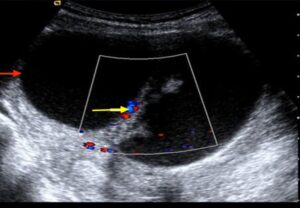
Figure 1: Transabdominal sonography showing bilobed cyst (red arrow) and torsion (yellow arrow). 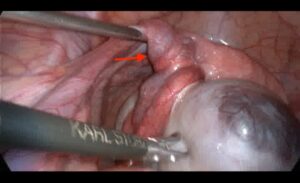
Figure 2: Left ovarian cyst with torsion of adnexa (yellow arrow). No ovarian discoloration.
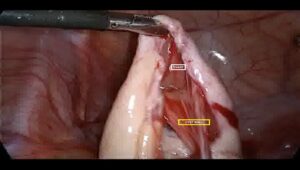
Figure 3: Cystectomy by traction and countertraction method. Cyst wall shown by arrow. 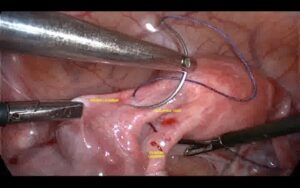
Figure 4: Hot Dog in Bun Technique of oophropexy. Ovarian and round ligament act as buns and fallopian tube as hotdog.
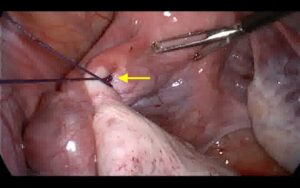
Figure 5: Knot placed posteriorly below ovarian ligament after taking lateral mattress sutures.
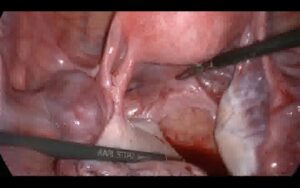
Figure 6: Preserved anatomy post oophropexy.
Discussion
The fifth most common gynecological emergency is ovarian or adnexal torsion. In pubescent girls due to growth factors and hormonal influences there is an augmented risk of physiological as well as pathological masses. Torsion is commonly noted in large ovaries with cysts of >5 cm, with benign functional cysts and mature cystic teratomas being the commonest [1]. Adnexal torsion in girls in their childhood and adolescence can occasionally happen without an ovarian cyst. Congenital elongation of ovarian ligament, laxity of pelvic ligaments and small uterine size enables torsion by permitting unwarranted adnexal mobility. As girls grow older and enter puberty, the utero-ovarian ligament gets shorter [2,3].
The most typical clinical sign of ovarian torsion is typically sudden, intense abdominal pain. Other often seen manifestations include low-grade fever, nausea and vomiting, which are non-specific symptoms. As these symptoms are capricious, diagnosis often gets delayed. Studies have shown nausea and vomiting to be present in 62 and 67% of cases respectively whereas rebound tenderness is usually present in 88% patients with adnexal torsion [4]. Events of torsion and detorsion can ultimately cause permanent functional ovarian impairment due to ischemia, stromal edema, internal hemorrhage and subsequent necrosis. It thus becomes pertinent to be cautious and sentient when dealing with ovarian torsion in young women.
A pelvic ultrasound along with colour doppler and an accurate clinical examination can cling the diagnosis. Transabdominal ultrasound remains the diagnostic modality of choice. Ultrasonography may reveal unilaterally enlarged ovary, ovarian edema characterized by free fluid, a coiled vascular pedicle, peripherally displaced follicles and echogenic stroma (the “whirlpool sign”) [1,5]. Reduced ovarian blood flow on colour doppler points towards ovarian torsion. Absence of arterial flow, little or non-existent venous flow, asymmetrical flow between the two ovaries are some cited colour doppler findings. Recurrent events of torsion and spontaneous detorsion may sometimes go undetected on sonography and doppler.
Surgical detorsion with the laparoscopic approach is the preferred treatment modality. Once diagnosis is made the treatment ranges from cystectomy to Oophropexy to oophorectomy. The aim is to preserve fertility in these young pubertal girls. Ovarian viability is assessed by visualization – bluish black enlarged ovary may have impaired blood flow. However, it is frequently reversible. A cut made after a wash with warm saline will show bleeding indicating a patent vascular supply. Once ovarian viability is confirmed ovary is detorted. Conservative care should not be hampered by the presumed possibility of a thromboembolic event after detorsion. Oophorectomy is performed for non-salvageable ovaries whereas cystectomy is preferred in younger women with viable ovarian function [6].
In cases of long ovarian pedicle or girls and women with recurrent ovarian torsion Oophropexy is performed. Oophoropexy aims to hitch the ovary to adjacent pelvic structures and limit its movement, thereby preventing repeated torsion. Literature has an abundance of techniques for ovarian fixation either to pelvic side wall, uterosacral ligaments or to anterior or posterior abdominal wall. Plication of utero-ovarian ligament not only fixes the ovary but also shortens the ligaments and prevents recurrent torsion.
We performed Oophropexy due to history of recurrent torsion and detorsion in this young girl. We followed the technique of ‘Hot Dog in Bun’ which was first described by J D Kondrup in 2012, in which he plicated the round ligament to the utero-ovarian ligament [7]. With or without ovarian ligament shortening, the fallopian tube is positioned inside the hotdog in between the utero-ovarian and round ligaments, which serve as the bun in this approach [8].
The suture, which may or may not be absorbable, is atraumatically conducted from the ovarian ligament through the round ligament, the mesosalpinx’s avascular region and back to be knotted posteriorly. The anatomical relationships between the ovaries, tubes and uterus seem to be preserved by this technique [9,10].
Preserving the tuboovarian relationship is important in the young and reproductive age group with fertility concerns. Care should be taken while tying the suture to avoid damaging the fallopian tube and selecting an avascular area in the mesosalpinx for taking the suture bite. This technique protects the fallopian tubes from compression in addition to restraining the ovarian mobility.
Conclusion
In pubescent girls presenting with sharp abdominal pain differential diagnosis of ovarian torsion must always be considered. Avoiding delay in diagnosis to surgery time in these patients is of foremost importance to preserve future fertility. Intraoperative assessment of adnexa for restoration of vascularity after detorsion allows preservation of ovarian function and fertility. Oophropexy is an effective preventive measure for recurrent torsion. Though no surgical technique of oophropexy is superior to another, The simplest technique that guarantees both the prevention of recurring torsion and the maintenance of the adnexal anatomy is the hotdog in bun technique.
Conflict of Interest
The author(s) have no conflicts of interest relevant to this article.
Funding
This research received no specific grant from any funding agency, commercial or not-for profit sectors.
References
- Adnexal torsion in adolescents: ACOG committee opinion No, 783. Obstet Gynecol. 2019;134(2):e56-63.
- Mahonski S, Hu KM. Female nonobstetric genitourinary emergencies. Emerg Med Clin North Am. 2019;37(4):771-84.
- Karaman E, Beger B, Çetin O. Ovarian torsion in the normal ovary: a diagnostic challenge in postmenarchal adolescent girls in the emergency department. Med Sci Monit. 2017;23:1312-6.
- Adams K, Ballard E, Amoako A. When is it too late? Ovarian preservation and duration of symptoms in ovarian torsion. J Obstet Gynaecol. 2022;42(4):675-9.
- Naffaa L, Deshmukh T, Tumu S. Imaging of acute pelvic pain in girls: ovarian torsion and beyond. Curr Probl Diagn Radiol. 2017;46(4):317-29.
- Diagnosis and management of adnexal torsion in children, adolescents and adults. J Obstet Gynaecol Can. 2017;39(2):82-90.
- Kondrup JD, Measick J. Ooophropexy: Hot Dog in a bun technique. OB/Gyn. Lourdes Hospital, Birmingham. NY. J Minimally Invasive Gyn Surgery. 2012;19:S151-78.
- Smorgick N, Mor M, Dovev MN. Combined utero-ovarian and round ligament oophoropexy for recurrent torsion of normal adnexa: a case series. J Pediatr Adolesc Gynecol. 2023;36(5):484-7.
- Pappachan C, Minna UR, Presanna Kumari B. Minimally invasive conservative management of ovarian torsion by hotdog in a bun technique: A case series. Int J Clin Obstet Gynaecol. 2020;4(4):293-6.
- Shah NH, Joshi AV, Belekar G. Hotdog in bun: A recent technique for oophoropexy. Int J Reprod Contracept Obstet and Gynecol. 2019;8(5):2100-2.
Author Info
Shazia Khan1*, Saranya Krishnan2, Sushil Chawla3
1Associate Professor, Department of Obstetrics and Gynecology, INHS Asvini, Mumbai, Maharashtra, India
2Resident (PGY 3), Department of Obstetrics and Gynecology, INHS Asvini, Mumbai, Maharashtra, India
3Professor and HOD, Department of Obstetrics and Gynecology, INHS Asvini, Mumbai, Maharashtra, India
*Correspondence author: Shazia Khan, MBBS, MS (Obs and Gyn), FMIGS (APAGE-MIT), Associate Professor, Department of Obstetrics and Gynecology, INHS Asvini, Mumbai, Maharashtra, India; Email: [email protected]
Copyright
Shazia Khan1*, Saranya Krishnan2, Sushil Chawla3
1Associate Professor, Department of Obstetrics and Gynecology, INHS Asvini, Mumbai, Maharashtra, India
2Resident (PGY 3), Department of Obstetrics and Gynecology, INHS Asvini, Mumbai, Maharashtra, India
3Professor and HOD, Department of Obstetrics and Gynecology, INHS Asvini, Mumbai, Maharashtra, India
*Correspondence author: Shazia Khan, MBBS, MS (Obs and Gyn), FMIGS (APAGE-MIT), Associate Professor, Department of Obstetrics and Gynecology, INHS Asvini, Mumbai, Maharashtra, India; Email: [email protected]
Copyright© 2025 by Khan S, et al. All rights reserved. This is an open access article distributed under the terms of the Creative Commons Attribution License, which permits unrestricted use, distribution, and reproduction in any medium, provided the original author and source are credited.
Citation
Citation: Khan S, et al. Hot Dog Bun Technique for Laparoscopic Oophropexy: A Panacea for Recurrent Ovarian Torsion? J Surg Res Prac. 2025;6(1):1-7.

